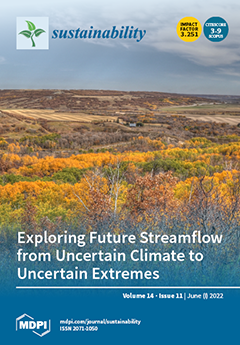Open AccessArticle
Spatiotemporal Analysis of Fire Foci and Environmental Degradation in the Biomes of Northeastern Brazil
by
José Francisco de Oliveira-Júnior, Munawar Shah, Ayesha Abbas, Washington Luiz Félix Correia Filho, Carlos Antonio da Silva Junior, Dimas de Barros Santiago, Paulo Eduardo Teodoro, David Mendes, Amaury de Souza, Elinor Aviv-Sharon, Vagner Reis Silveira, Luiz Claudio Gomes Pimentel, Elania Barros da Silva, Mohd Anul Haq, Ilyas Khan, Abdullah Mohamed and El-Awady Attia
Cited by 12 | Viewed by 2611
Abstract
Forest fires destroy productive land throughout the world. In Brazil, mainly the Northeast of Brazil (NEB) is strongly affected by forest fires and bush fires. Similarly, there is no adequate study of long-term data from ground and satellite-based estimation of fire foci in
[...] Read more.
Forest fires destroy productive land throughout the world. In Brazil, mainly the Northeast of Brazil (NEB) is strongly affected by forest fires and bush fires. Similarly, there is no adequate study of long-term data from ground and satellite-based estimation of fire foci in NEB. The objectives of this study are: (i) to evaluate the spatiotemporal estimation of fires in NEB biomes via environmental satellites during the long term over 1998–2018, and (ii) to characterize the environmental degradation in the NEB biomes via orbital products during 1998–2018, obtained from the Burn Database (BDQueimadas) for 1794 municipalities. The spatiotemporal variation is estimated statistically (descriptive, exploratory and multivariate statistics) from the Normalized Difference Vegetation Index (NDVI), Enhanced Vegetation Index (EVI) and Standardized Precipitation Index (SPI) through the Climate Hazards Group InfraRed Precipitation Station (CHIRPS). Moreover, we identify 10 homogeneous groups of fire foci (G1–G10) with a total variance of 76.5%. The G1 group is the most extended group, along with the G2 group, the exception being the G3 group. Similarly, the G4–G10 groups have a high percentage of hotspots, with more values in the municipality of Grajaú, which belongs to the agricultural consortium. The gradient of fire foci from the coast to the interior of the NEB is directly associated with land use/land cover (LULC) changes, where the sparse vegetation category and areas without vegetation are mainly involved. The Caatinga and Cerrado biomes lose vegetation, unlike the Amazon and Atlantic Forest biomes. The fires detected in the Cerrado and Atlantic Forest biomes are the result of agricultural consortia. Additionally, the two periods 2003–2006 and 2013–2018 show periods of severe and prolonged drought due to the action of El Niño.
Full article
►▼
Show Figures





